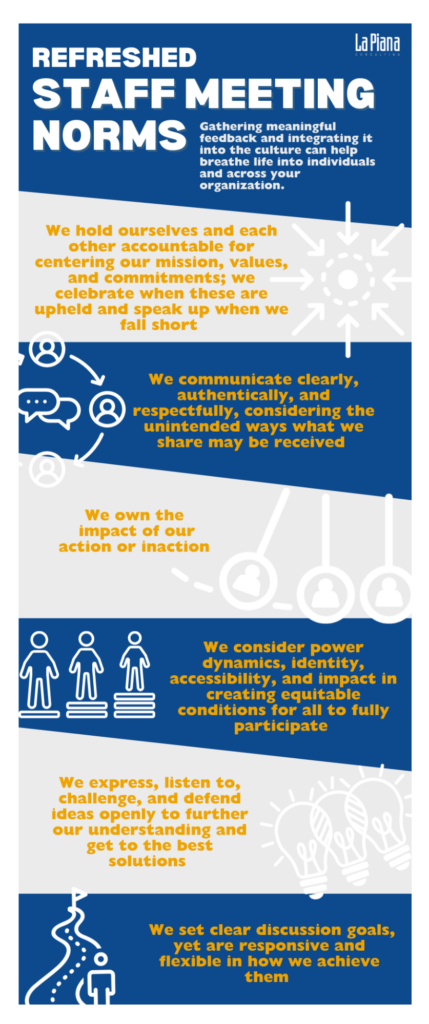From Insight to Action: Unveiling the Art of Transformative Feedback
Since my first nonprofit job as an intern over a decade ago, leading up to my current role as an associate consultant at La Piana, I’ve always been intrigued by the distinct ‘worlds’ we all contribute to and experience as work culture. In the HBR article, Company Culture is Everyone’s Responsibility, the author describes workplace culture as simply the ways people in an organization behave and the attitudes and beliefs that inform those behaviors (i.e., “the way we do things around here”). And of course, each ‘we’ has plenty of distinctions. 
Every organization’s culture is unique yet tends to express itself at the intersections of the formal and informal, the spoken and unspoken, and the lived and the hoped for, and teams are likely to take notice. According to Forbes, 46% of job seekers named culture as a top reason for applying to a new job, and 47% named company culture as their driving reason for seeking a new role. Dr. Jim Harter, the chief workplace scientist at Gallop, called managers/team leaders ‘the silver bullet’ to a lousy, good, or great culture. Gallop’s research found that a hefty 70 percent of a team’s engagement is influenced by its manager. From what I’ve observed, a good portion of that engagement is inspired by the expression (or absence) of meaningful feedback. It is the catalytic nature of feedback that makes it such an important element in an organization’s culture.
For the past year and a half, as part of a feedback subcommittee at La Piana, I have witnessed the transformative power of thoughtful feedback firsthand. The subcommittee was developed to help create and integrate a range of feedback mechanisms that account for the inherent firm power dynamics. It has been energizing to see a direct connection between input from colleagues, our shared values, and actions with immediate impact. For example, we have refreshed staff meeting norms based on staff feedback (see graphic at right). Such a simple solution, but it makes a difference to start meetings with a call to be present, thoughtful, and accountable.
The following elements have stood out to me about what differentiates meaningful feedback that transforms cultures and individuals. What elements (listed or not) stand out most to you?
Meaningful Feedback…
- Acknowledges power dynamics
It is useful to ask ourselves how our own relationship to power may be influencing how we offer, invite, give, and receive feedback. Whether positional power, social power, or a convergence of both, meaningful feedback is mindful of differences and the potential for imbalance. Skip the sandwich (the practice of slapping some ‘positive’ feedback before and after ‘negative’ feedback). Instead start with the “why” behind the feedback, and include framing in terms of organizational mission, values, and goals – what we’re working towards together
- Is Multi-directional and multi-dimensional
The norm and expectation should be for feedback (of all kinds from celebratory and constructive) to flow in all directions in an environment of trust and vulnerability. Support this effort with a variety of options and opportunities for sharing feedback (anonymous comment box, supervisory meetings, one off conversations, surveys, etc.)
- Does not assume one size fits all
Just like every organization’s culture is different, every individual who adds to that culture is unique. Do not shy away from problem solving and having tough conversations as a team to find the delivery methods that resonate and ultimately lead to change
- Is relevant and actionable
Meaningful feedback is focused and forward looking, aligned with the overall goals and objectives of an individual and the organization as a whole. This ensures that the feedback is directly tied to the larger context of the work.
- Is timely and consistent
Feedback shouldn’t need an invitation or a special event. Work it into conversations in real time AND schedule dedicated time for debrief and discuss. It is the practice over time that builds relationships and refines the practice of giving and receiving feedback.
As the HBR article aptly puts it, culture is the sum of behaviors, attitudes, and beliefs that define “the way we do things around here.” It’s a mosaic that manifests at the crossroads of the formal and informal, the spoken and unspoken. Being part of La Piana’s feedback subcommittee has shown me how valuable feedback can be for shaping a company’s culture. It boosts engagement by recognizing power dynamics, encouraging open communication from all directions, avoiding one-size-fits-all methods, staying relevant and actionable, and being timely and consistent. Celebrating the impact of meaningful feedback highlights its role in reinforcing shared values and actions. This emphasizes that cultivating a feedback culture brings vitality to individuals and organizations, creating a story of growth, adaptability, and a collective commitment to continuous improvement.


Thank you LP 🙏